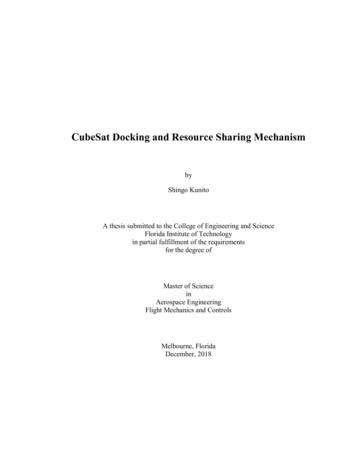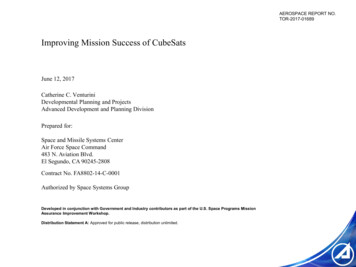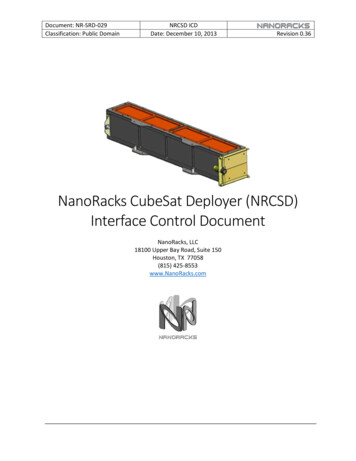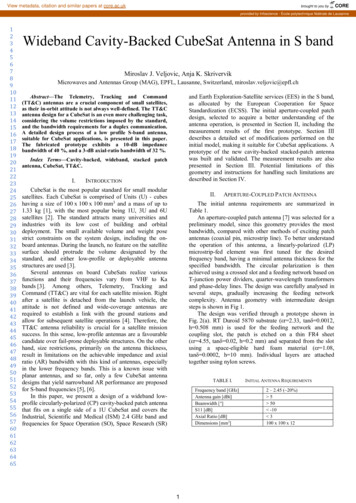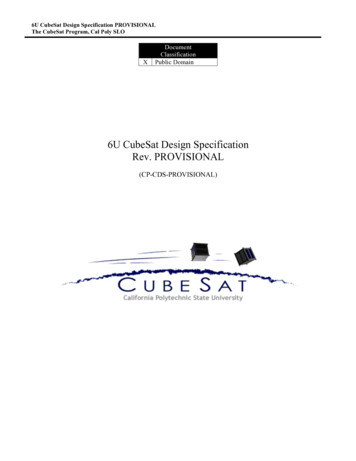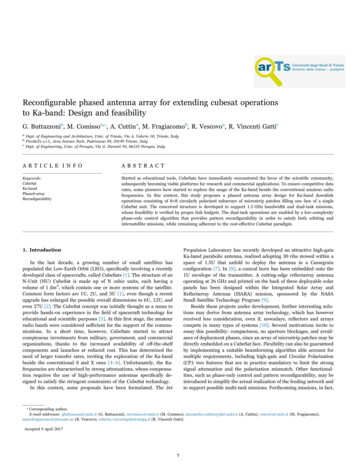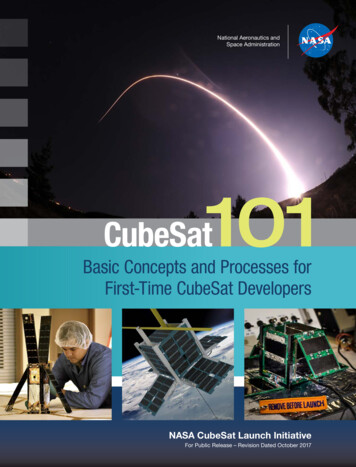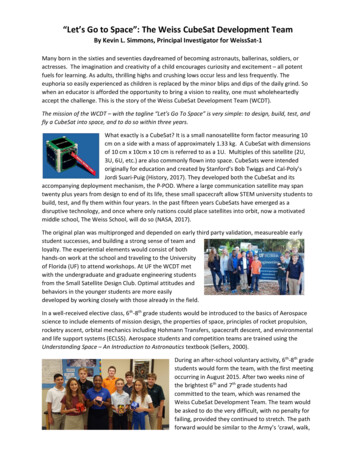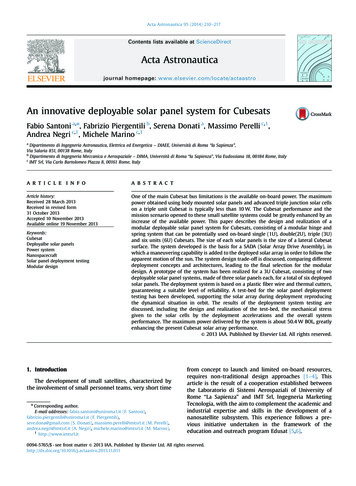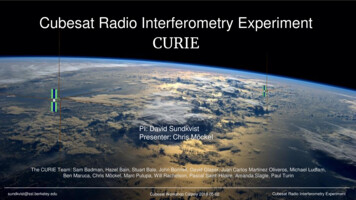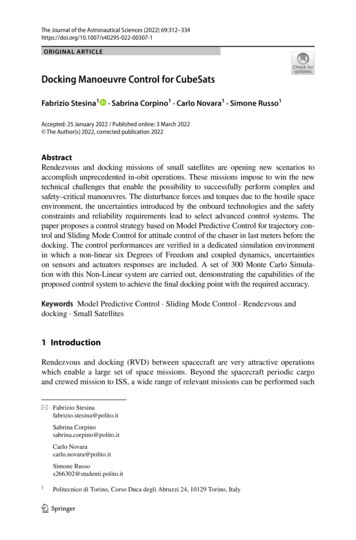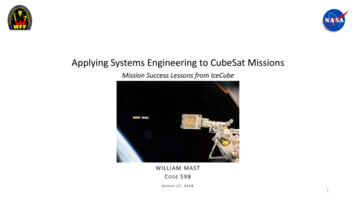
Transcription
Applying Systems Engineering to CubeSat MissionsMission Success Lessons from IceCubeWILLIAM MASTC ODE 5 9 8AUGUST 17, 20181
G U I D A N C E N A V I G AT I O N & C O N T R O L &M ISSION S YSTEMS E NGINEERING B RANCH ( C ODE598)Contents IceCube Mission Background Systems Engineering Applied to the IceCube Mission Recommendations for Improving Mission Successper. Mission Assurance Improvement Workshop (MAIW) AEROSPACE REPORT NO. TOR-2017-01689 1. Build an experienced team—it matters 2. Define your scope, goals, and success criteria at program start 3. Conduct risk-based mission assurance 4. Design for simplicity and robustness 5. Maintain a healthy skepticism on vendor subsystem datasheets 6. Plan for ample IV&T time 7. Stock spare components 8. At a minimum, perform the four mission assurance tests Lessons learned Knowledge Capture The Future2
G U I D A N C E N A V I G AT I O N & C O N T R O L &M ISSION S YSTEMS E NGINEERING B RANCH ( C ODE598)IceCube Mission Background The IceCube Mission was proposed and won by Dr. Jamie Esper (GSFC/592) and Dr. Dong Wu(GSFC/613) in 2013 GSFC’s First Science Mission on a CubeSat ---- Not a Tech Demo Clear Objective “raise the TRL of a COTS 874 GH submillimeter wave radiometer technology from 5 to6 with a ground test and from 6 to 7 with a 30 day on orbit test PI, Science Team, and Instrument development and build at Greenbelt Campus Budget and Schedule for COTS Integration effort only, no Bus technology development, 2 years to Launch AETD began mission support in May 2014 1 full time SE to tailor 7123 processes tailored to CubeSat missionFractional FTE Support from Discipline Engineers at WFF campus 0.1-.3 FTE per yearPM and Additional Discipline Support as availableProject worked seamlessly across two GSFC campuses3
G U I D A N C E N A V I G AT I O N & C O N T R O L &M ISSION S YSTEMS E NGINEERING B RANCH ( C ODE598)Recommendations for improving Mission Successper U.S. Space Program Mission Assurance Improvement Workshop (MAIW) OTR 2018-00851At SmallSat 2018, Catherine Ventrini of the Aerospace Corporation presented 8 recommendations toimprove mission success for CubeSats as the result of a 9 month study of 94 satellites. OTR 2018-00851The Recommendations Span the Project Cycle and I found them to be essential to the success of theIceCube Mission. With permission, I am borrowing these to describe the structure of the IceCube Mission1. Build an experienced team—it matters2. Define your scope, goals, and success criteria at program start3. Conduct risk-based mission assurance4. Design for simplicity and robustness5. Maintain a healthy skepticism on vendor subsystem datasheets6. Plan for ample IV&T time7. Stock spare components8. At a minimum, perform the four mission assurance testsThe entire report is: AEROSPACE REPORT NO. TOR-2017-01689
G U I D A N C E N A V I G AT I O N & C O N T R O L &M ISSION S YSTEMS E NGINEERING B RANCH ( C ODE1. Build an experienced team—it matters598)-What worked PI/Instrument team -- Many had just finished the SMAP mission. Expertise withradiometers on both space and airborne platforms. PM/Tech Advisor – Experience with Balloon and Small Orbital experiments Systems Engineer -- LADEE Deputy Mission SE, 2008 - 2013 Experience Applying NASA SE process to small platforms Discipline Spacecraft Team -- extensive hand on experience adapting andintegrating COTS and low TRL hardware in suborbital applications Mission Planning Lab Staff composed most of the teamWallops 6U CubeSat Bus and Deployer – 2008CREAM ballooncraft Mission, MLAS, Sounding RocketsFirefly 3U CubeSat acquisition and trackingSpecialized Greenbelt support for thermal, grounding, electronics Cooperation and collaboration with Dellingr, CeRES, and DICE GroundStation teams.
G U I D A N C E N A V I G AT I O N & C O N T R O L &M ISSION S YSTEMS E NGINEERING B RANCH ( C ODE598)1. Build an experienced team—it matters-What could have gone better Team took several months to fully assign, Most WFF discipline engineers were assigned to higher priority projects PM, Thermal, and Electronics support available 6mo - 1 year into the project. Most Discipline Engineers were constrained to 10% - 20% of their time Entire team was on a CubeSat learning curve Reassignment and loss of key team members occurred throughout theproject cycle
2. Define your scope, goals, and success criteria at program startG U I D A N C E N A V I G AT I O N & C O N T R O L &-What workedM ISSION S YSTEMS E NGINEERING B RANCH ( C ODE 5 9 8 ) SRR/MDR 3 months into the project Requirements Matrix defined to level 4 High Level requirements remained stable through the project, lower level revisited often Identified design tall poles to prioritize: Instrument temp. between 20-30C stable to 1C over 1.5 minute observation Nominal Spacecraft rotation about the sun vector of 3 minutes per revolution Geolocate the observation within 15km System Block Diagram -defining all interfacesScience Operations and capabilities defined using MPL simulationsBaseline Concept of Operations Document for Space and Ground SegmentsBaseline Master Equipment List (MEL)Basic Instrument ICD
G U I D A N C E N A V I G AT I O N & C O N T R O L &M ISSION S YSTEMS E NGINEERING B RANCH ( C ODE598)Requirements and Risk Tracking
G U I D A N C E N A V I G AT I O N & C O N T R O L &M ISSION S YSTEMS E NGINEERING B RANCH ( C ODE598)Concept of Operations Formulation Produced detailed simulations of instrument FOV, Solar Exposure, and GroundStation Access to validate the operations concept and define the quantity of data9
G U I D A N C E N A V I G AT I O N & C O N T R O L &M ISSION S YSTEMS E NGINEERING B RANCH ( C ODEArchitecture598)10
2. Define your scope, goals, and success criteria at program startG U I D A N C E N A V I G AT I O N & C O N T R O L &-What could have gone betterMISSION SYSTEMS ENGINEERING BRANCH (C598)ODE Project would have benefitted from a Safety and Misson Assurance(SMA) Plan and a Systems Engineering Management Plan (SEMP)rolled into the Project Plan. This is where tailoring would have been defined and documented Needed a Clear definition of Stakeholders expectation for reliability “Do No Harm” – (launch constraint, not an SMA level) “It has to work” Many Unanticipated Development Efforts were encountered over thecourse of the project Not requirements creep, these are problems that need to be solved beyondthe budget and schedule reserves. CubeSats require much larger reserves as a percentage than larger projects
2. Define your scope, goals, and success criteria at program startG U I D A N C E N A V I G AT I O N & C O N T R O L &-What could have gone betterMISSION SYSTEMS ENGINEERING BRANCH (C598)ODEExamples: Designed a first of it’s kind “Smart Beacon” to facilitate ground contact and troubleshootingCustom Bus Structure was needed to accomodate unique assembly, thermalm and bonding req.First-of-its-kind ISS compliant battery, charging, power distribution systemEPS card and Flight computer cards were made to different CubeSat Bus Standards requiredclipping pins and adding jumpersNew Star tracker capable of 3-axis attitude control,New ADACS software for a rotating platform,ADACS was incompatible with latest GPS firmware, had to have previous firmware installedCustom Flight Software interfaces had to be written for most componentsErrors in Flight Radio Command software found by trial and error and blocked out of flightsoftwareCustom Designed and spun science interface cardCustom Designed Paraffin phase-change thermal control device first on a CubeSatSearch and research for reliable deployment switches,Design and addition of Break-out Umbi connector to enable testingDesign and implementation of Grounding Plan. (every component handled power and RF groundsdifferently)3D printed wiring mockup so wiring could be done in parallel3D printed demonstration model for HQ while in the middle of integration
G U I D A N C E N A V I G AT I O N & C O N T R O L &M ISSION S YSTEMS E NGINEERING B RANCH ( C ODE598)3. Conduct risk-based mission assurance Maintained, a comprehensive list of both Action Items and Worries fromevery meeting Racked and tracked the top 10 risks Change Control Board Decisions based on risk, cost, benefit considerations I&T plan produced for CDR, based on LADEE plan, updated continuously Leverage experience of other CubeSat missions to assess risks Some Long lead time Hardware has to be Purchased at-risk prior to CDR Testing based on mission simulations
G U I D A N C E N A V I G AT I O N & C O N T R O L &M ISSION S YSTEMS E NGINEERING B RANCH ( C ODE598)4. Design for simplicity and robustness No redundant systems“Robustness” driven by risk mitigation De-Rated power system and ACS Standard using Spacecraft margins Able to charge batteries in random tumble without arrays deployed Distributed processor architecture allows numerous paths to resets afterlockups ConOps designed to compensate for hardware limitations Smart Beacon Common Ground system shared with Ceres and Dellinger
G U I D A N C E N A V I G AT I O N & C O N T R O L &M ISSION S YSTEMS E NGINEERING B RANCH ( C ODE5. Maintain a healthy skepticism on vendor subsystem datasheets598) All data sheets checked prior to component acceptance testing EPS manual found to have significant errors and sent back for revision Small errors found in many other datasheets Acceptance testing is where you will find the errors Lock up your hardware, DO NOT LOOSE CONTROL OF YOUR HARDWARE You will never know if the component has a vendor error or was damaged after receipt Some Radio commands had sw bugs – worked on this up to 2 days before delivery ADACS received in wrong configuration, sent back for re-programming ADACS found to be incompatible with newer GPS firmware, had to have firmwarebackdated
G U I D A N C E N A V I G AT I O N & C O N T R O L &M ISSION S YSTEMS E NGINEERING B RANCH ( C ODE598)6. Plan for ample IV&T time MAIW Paper Recommends that I&T should be 1/3 to ½ of schedule. IceCube I&T was roughly half of schedule. Significant overlap Between Design and I&T – July 2015 – March 2016 Graceful transition of technical leadership between design and test I&T manager and Payload Engineer brought onto project in July 2015 Systems Engineer transitioned off project in February 2016 No “Time Crunch Factor”, Testing was not shortened to accommodate the launch Project ran out of schedule and funds near the start of I&T, but found more funding ratherthan launch untested. There is a point in I&T when changes to the hardware are too costly and risky andproblems must be solved with operational changes
G U I D A N C E N A V I G AT I O N & C O N T R O L &M ISSION S YSTEMS E NGINEERING B RANCH ( C ODE598)7. Stock spare components Spares Limited by Budget and Procurement Process GPS Antenna Battery Engineering Unit procured and controlled as flight spare Radio Spare planned, but prohibited by price increase
G U I D A N C E N A V I G AT I O N & C O N T R O L &M ISSION S YSTEMS E NGINEERING B RANCH ( C ODE8. At a minimum, perform the four mission assurance tests598)ü1. Day-in-the-life (or longer) testingü2. Communication link testing with the ground stationü3. Power system charge/discharge testingü4. Thermal testing (in vacuum) Additional testing performedü Vibration testingü FlatSat component testing prior to integrationü Deployment Switch, Antenna and Solar Array deployment testingü Vacuum Deploymentsü Mission simulation test with solar arrays illuminated and thermal simulators to exercise allsoftware functionality – this test revealed a critical software error Testing Omitted EMI/EMC test, Open air Com Test, Phase Change Device Functional (Thermal) Test
G U I D A N C E N A V I G AT I O N & C O N T R O L &M ISSION S YSTEMS E NGINEERING B RANCH ( C ODEI&T Flow598)IceCube I&T Flow
G U I D A N C E N A V I G AT I O N & C O N T R O L &M ISSION S YSTEMS E NGINEERING B RANCH ( C ODE598)IceCube Systems Engineering Lessons LearnedDon’t !!!Skimp on Formulation Instead, Use Mission Planning Lab Simulations And Learn from other CubeSat missionsSkimp on Documentation Instead, Keep the content, simplify the format And Implement Configuration ManagementSkimp on Reviews - Peer reviews don’t negate Milestonelose Control of your Baseline – this is the only way to control creepLose Control of your Hardware – WOA and secure itLose Track of your Risks and worries - You need these to make decisionsProcrastinate Everything needs to start earlier than you expect mission phases will overlap
G U I D A N C E N A V I G AT I O N & C O N T R O L &M ISSION S YSTEMS E NGINEERING B RANCH ( C ODE598)Applying SE lessons to Planetary SmallSats The Systems Engineering Process seems to scale better down than up. LADEE started with larger GSFC missions and scaled down to Class D IceCUBE started with the LADEE documents and scaled down The CubeSat industry has matured Quickly and some of the development workneeded to complete IceCube would not be needed today Determining the right amount of reserves is challenging This is why the TRL definition effort is so important Planetary SmallSats are today where LEO CubeSats were 5 years ago NASA to lead in developing successful planetary SmallSat capabilities The first generation of Planetary SmallSats will experience a similar level of developmentalchallenges as IceCube. Following the 8 Recommendations from the onset of a project will improve mission successoverall
G U I D A N C E N A V I G AT I O N & C O N T R O L &M ISSION S YSTEMS E NGINEERING B RANCH ( C ODE598)ConcludeØApply a Systems Engineering Process Beginning to EndØAllocate sufficient schedule and budget reserves for completionØEarly and Complete documentation is a good financial investmentØAssign a stable dedicated multidiscipline Core team.How can the Science Community Help?vMine your housekeeping data to characterize your components forfuture missions-Battery Charge/Discharge, Solar Panel Aging, Contamination, ACS jittervAllocate the final portion of your CubeSat mission to exercising thehardware and characterizing the limits of hardware capability anddurability for the benefit of future missions-Antenna off-pointing, new ACS algorithms, Thermal model validation, exercise andcharacterized unused hardware modes.
Change Control Board Decisions based on risk, cost, benefit considerations I&T plan produced for CDR, based on LADEE plan, updated continuously Leverage experience of other CubeSat missions to assess risks Some Long lead time Hardware has to be Purchased at-risk prior to CDR Testing based on mission simulations
